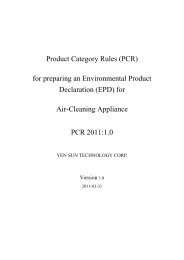Product Category Rules (PCR) - PCR Library
Product Category Rules (PCR) - PCR Library
Product Category Rules (PCR) - PCR Library
You also want an ePaper? Increase the reach of your titles
YUMPU automatically turns print PDFs into web optimized ePapers that Google loves.
Annex D (informative): Collection of fuel consumption data and calculation of GHG emissions for truck<br />
transport<br />
D.1 Fuel consumption method<br />
D1.1 Collect data on fuel consumption for each transport mean, and convert the unit of fuel consumption from “L”<br />
to “kg”.<br />
Fuel consumption = Fuel consumption (L) x Fuel density y (kg/L)<br />
Fuel density of gasoline: y = 0.75kg/L<br />
Fuel density of light oil: y = 0.83kg/L<br />
D.1.2 Calculate GHG emissions by multiplying fuel consumption (kg) by secondary data for each type of fuel.<br />
D.2 Fuel cost method<br />
D.2.1 Collect data on fuel cost (km/L) and transport distance (km) for each transport mean, and calculate fuel<br />
consumption by using the following equation.<br />
Fuel consumption (kg) = Transport distance (km) / Fuel efficiency (km/L) x y (kg/L)<br />
D.2.2 Calculate GHG emissions by multiplying fuel consumption (kg) by secondary data for each type of fuel.<br />
D.3 Ton-kilometer method<br />
D.3.1 Collect data on maximum loading capacity: “Z” (kg), loading ratio: “Y” (%) and GHG emissions by transport:<br />
“W” (ton-km) for each transport means. (Data on loading capacity shall be collected in principle, but may be<br />
omitted in inevitable cases).<br />
D.3.2 If loading ratio “Y” (%) is unknown, follow the scenario provided in the pertinent articles of this <strong>PCR</strong>.<br />
D.3.3 Multiply transport load (transport ton-kilometer) by secondary data of each transport means broken down by<br />
loading ratio.<br />
-21-















